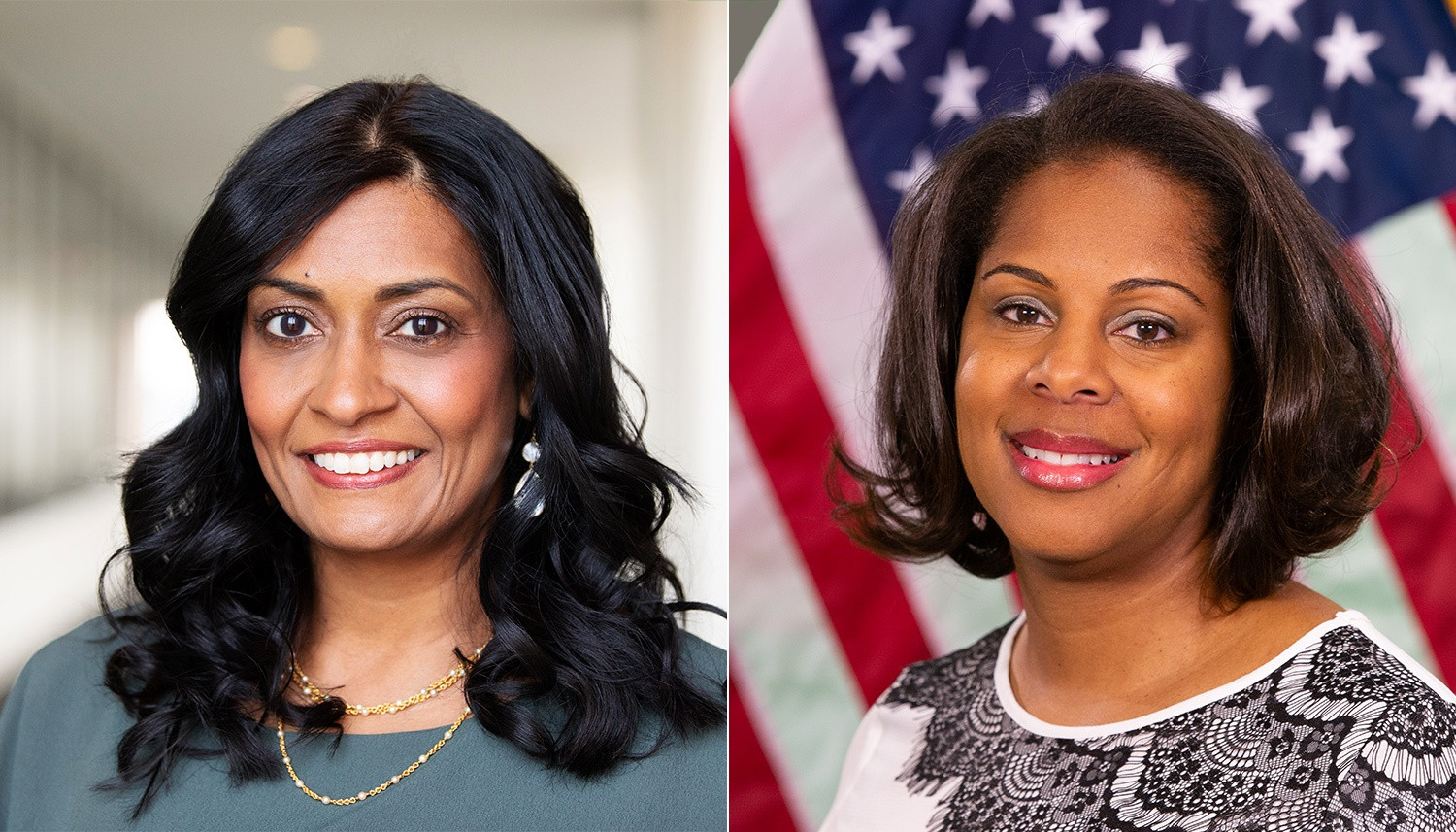
Kiesha Bryant (left), a USPTO hiring director, and Commissioner for Patents Vaishali Udupa. (Photo by Jay Premack/USPTO)
Discussing examiner hiring with Commissioner for Patents Vaishali Udupa
At the USPTO headquarters in Alexandria, Virginia, Commissioner for Patents Vaishali Udupa recently sat down with Kiesha Bryant, Director of Technology Center 3700 (mechanical engineering, manufacturing, gaming, and medical devices/processes) and a hiring director at the agency, to discuss the hiring of patent examiners.
The USPTO plans to hire at least 800 patent examiners by the end of this fiscal year on September 30. To learn more about the hiring process itself, visit our Become a patent examiner page. (This Q&A has been edited for brevity)

Commissioner for Patents Vaishali Udupa and Director of Technology Center 3700 Kiesha Bryant
Ms. Bryant to Commissioner Udupa: What’s the USPTO’s strategy for hiring talented professionals who work here for many years?
Udupa: We want to continue acquiring top-level talent from a variety of scientific and technological backgrounds, as well as in architecture, art, photography, and industrial design. We’re seeking people who have an inquisitive mind. There's no specific intellectual property (IP) background necessary – we'll train you. During the examiner's first four months, they attend our training academy, and for the next eight months they will take on-demand classes while being coached by highly experienced examiners. After the first year, there's ongoing training as they continue to become fully integrated into the agency.
I have been working in IP for nearly a quarter-century. Early on, I had a lot of interactions with examiners, and I remain very impressed. It’s an amazing, intellectual, dedicated, and adaptive group, with a strong background in science and technology.
I’ve talked to so many people who have been working here for 20 years or more, some for even 40 years. People stay because they love the agency, the people they work with, and the work they do.
Udupa to Bryant: In what ways are you working to acquire talent from across the country?
Bryant: There are qualified scientists and engineers – and people pursuing careers in these fields – all across the country. We've learned that some candidates may not be getting enough attention, because they’re not from the big schools.
Now, we’re focusing more effort on smaller schools. We’ve more than doubled the number of college career fairs we visit to 75-80 each recruiting season. We’re hiring dedicated employees, who are excited to have the ability to achieve work-life balance while still living in their hometowns.
During our conversations with potential job candidates, we’re promoting all the benefits of working here. For instance, employees are eligible for financial bonuses based on individual performance alone. And promotions can be achieved without going through a competitive hiring process.
Udupa to Bryant: How is the USPTO engaging with historically Black colleges and universities?
Bryant: Over the last couple of years, we’ve increased our focus on attending career fairs at HBCUs and minority-serving institutions. When we visit these campuses, we explain how their students’ talents would benefit our agency.
There are also minority-based conferences that we may not have been able to attend in the past. We’re attending these now, and we’re working with the USPTO’s affinity groups to make lasting connections with minority-based institutions. We’re seeing an increase in people applying, and they’re asking us to return to their campuses.
Bryant to Udupa: How did you first encounter the USPTO?
Udupa: In 1996, the USPTO recruited at the University of Virginia, and I was lucky enough to get an interview. This was my first exposure to the agency, which opened my eyes to the amazing career opportunities at the USPTO.
You have to be a U.S. citizen to work at the USPTO, and at the time I was ineligible to apply because I was born in Canada and still had my Canadian citizenship. I later obtained my U.S. citizenship, and after finishing law school I did patent-related work at a couple of law firms. I later moved to Hewlett-Packard. Then, I got this great opportunity to join the USPTO as the Commissioner for Patents. People come here to make sure innovation is protected, which helps our economy and national security, and creates jobs.
Udupa to Bryant: When should people apply?
Bryant: Now. The job announcement is always open. And we hire and interview candidates as early as nine months before their college graduation.
We have virtual office hours on Wednesdays at noon ET with our hiring managers, to give candidates the opportunity to ask questions in real-time about what the job entails. Then, for information on the status of a job application, an applicant can contact Human Resources (HR) directly.
Bryant to Udupa: What’s it like to telework, with flexible schedules?
Udupa: Telework and flexible work schedules are great benefits. Whether you want to come into the office or you want to work remotely from home – whether that’s in Alexandria, Virginia, or some rural area, by the beach, or up in the mountains – you can do that. We give you the equipment to work from wherever you want in the United States.
I have this great job, but I also have a family and other responsibilities. For example, my kids play sports, and I love to attend their events. Employees have the flexibility to work when it’s convenient, as long as they make sure they meet their productivity requirements.
Bryant to Udupa: For a new examiner, why is this a great place to work?
Udupa: Just imagine that every day, you receive a patent application on your desk that might be the newest, greatest thing. You get to witness that, be part of that, and help that innovation get protection.
Bryant: I completely agree. Thanks again for taking the time to meet with me.
To apply to be a patent examiner, go to usajobs.gov.
Engage with the Director and join the conversation on our social media channels.






